VIRGINIA GORDON
Communications Coordinator
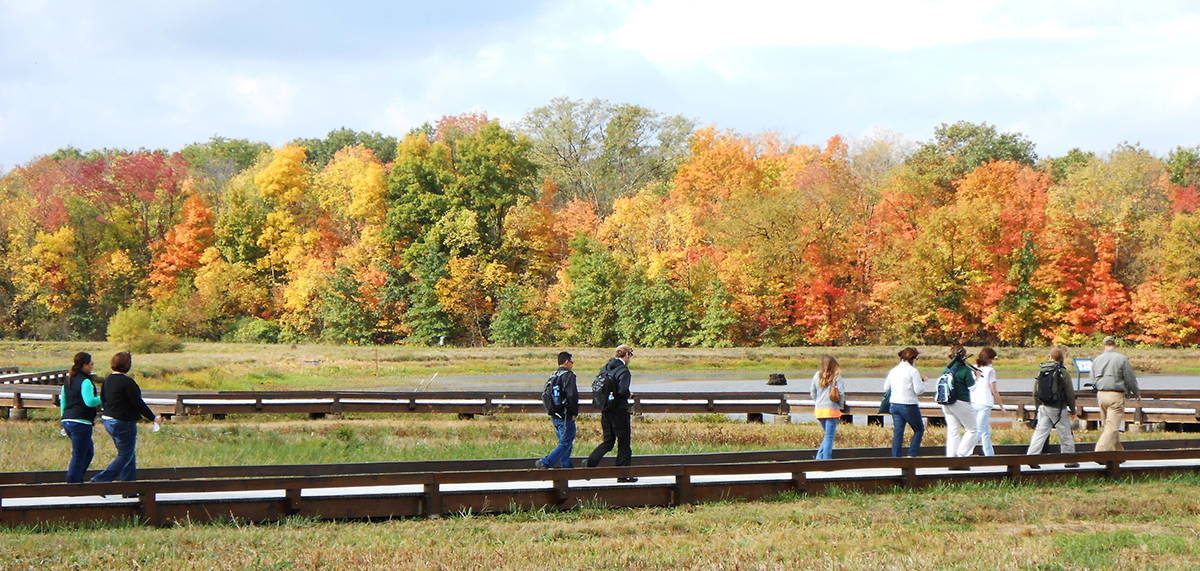
Slate Run, when it opened in 1981, became the largest Metro Park in the Columbus and Franklin County Metropolitan Park District. In 1963, a full 18 years earlier, Metro Parks had taken its first looks at land along Slate Run in Pickaway County, and saw potential for a large metropolitan park in the area. At the time, there were only three parks open in the Columbus and Franklin County Metropolitan Park District. None of them were particularly large. Blacklick Woods had by then been open for 15 years, and had expanded from its original 113 acres to 460 acres. At 396 acres, Blendon Woods, which opened in 1951, had yet to experience the expansion that would take it to its present-day 653 acres. Whilst the newest park, Darby Creek Metro Park, open by then for just the past four years, was a mere 119 acres in size.
Other land had already been acquired at sites that would eventually become Metro Parks. These included land at the future parks, Highbanks, Sharon Woods and Chestnut Ridge. In those years, there was a lot of concern about losing natural areas to housing or industrial development. Metro Parks’ funding was not as robust as it would become in later decades, and so land acquisition, to protect and preserve natural areas that had the potential to become parks, became a priority for Metro Parks. Park development would have to wait until sufficient funds could be garnered to implement capital improvement projects. So it was, that Metro Parks acquired 1,662 acres of land along Slate Run between 1964 and 1968.
Sharon Woods opened in 1968, and Highbanks in 1973, so Slate Run would become the sixth Metro Park when it opened in 1981, as well as being the then largest. Today, with a slight expansion to 1,705 acres, it remains one of our larger parks, in fact the fourth largest, behind Battelle Darby Creek, Clear Creek and Prairie Oaks Metro Parks.
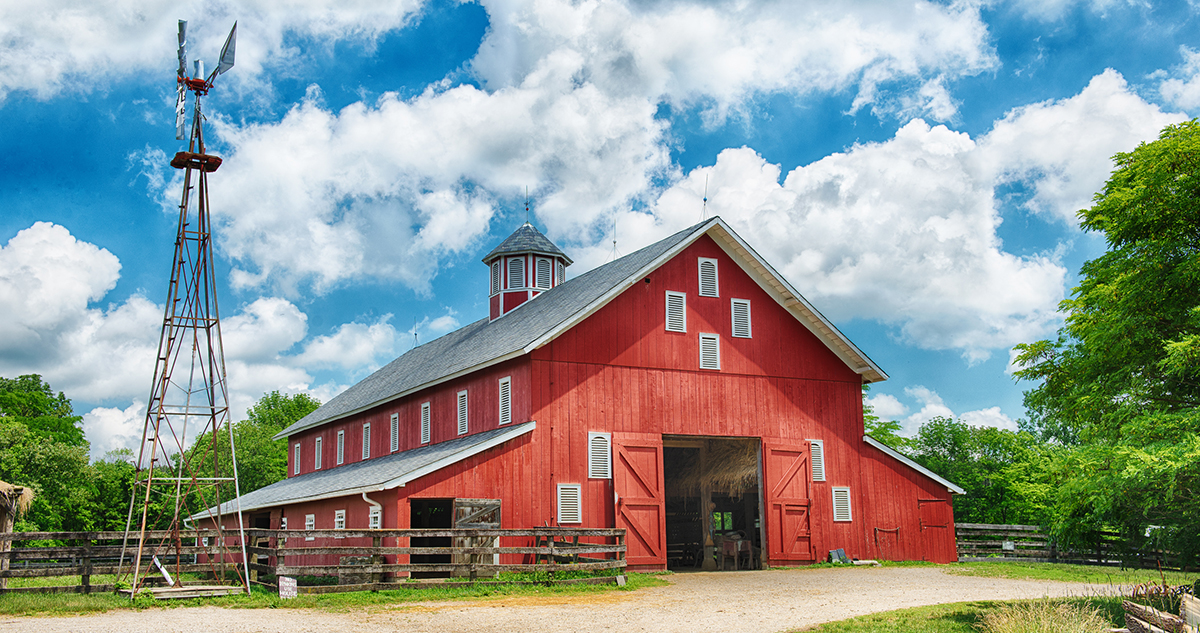
There was never much doubt about what the name of the park would be. Slate Run was the largest of two streams running south to northwest and cutting through a north to south ridge. Although much of the land had been farmed, and was still being farmed, the two heavily wooded ravines, through which Slate Run and a smaller stream flowed, gave it a wild and rugged character. From the beginning, Metro Parks intended to develop a living historical farm on the site. Of the 22 separate parcels of land that formed the future park area, one, in particular, showed immense promise for development as the living historical farm. The 212-acre site, purchased from the White family, had been in use as a farm continuously since 1805. It contained numerous buildings that could be utilized. The farmhouse had been built in 1856, when the farm was owned by Isaac Fridley, and the site also contained an extensive barn, built in 1881 when ownership of the farm was in the hands of Samuel Oman. Both of these buildings were structurally sound, but needed extensive renovation. A number of other buildings on site were from the 1880 to 1910 period, which led to a design decision to center the living historical farm on that period, with specific emphasis on the decade of the 1880s.
THE DAY CAMP MAKES ITS BOW
Although the park was yet 10 years away from its opening, Metro Parks opened a primitive day camp on site in 1971, to help with the demand for day camp facilities from scouts and other youth groups. As it remains to this day, the primitive day camp had its own dedicated entrance, off Neiswander Road, in the far north-east sector of the park. Two separate camp sites were available, each accommodating 40 people. The 55-acre site is today known as Camp Starview and continues to be available, by reservation only, for boy scout and girl scout groups, plus organized youth and church groups. Scouts only are allowed to use the camp for overnights as well as day camps. Capacity is today expanded to 50 people at the two adjacent sites. The area contains its own 2-mile nature trail.
A WISHLIST FOR THE PARK
As there were no funds available for immediate park development, Metro Parks entered arrangements with some of the previous landowners to lease the land to them so they could continue to live on and work the land. Those arrangements lasted through to 1975, when Metro Parks turned to serious contemplation of how the park might be developed.
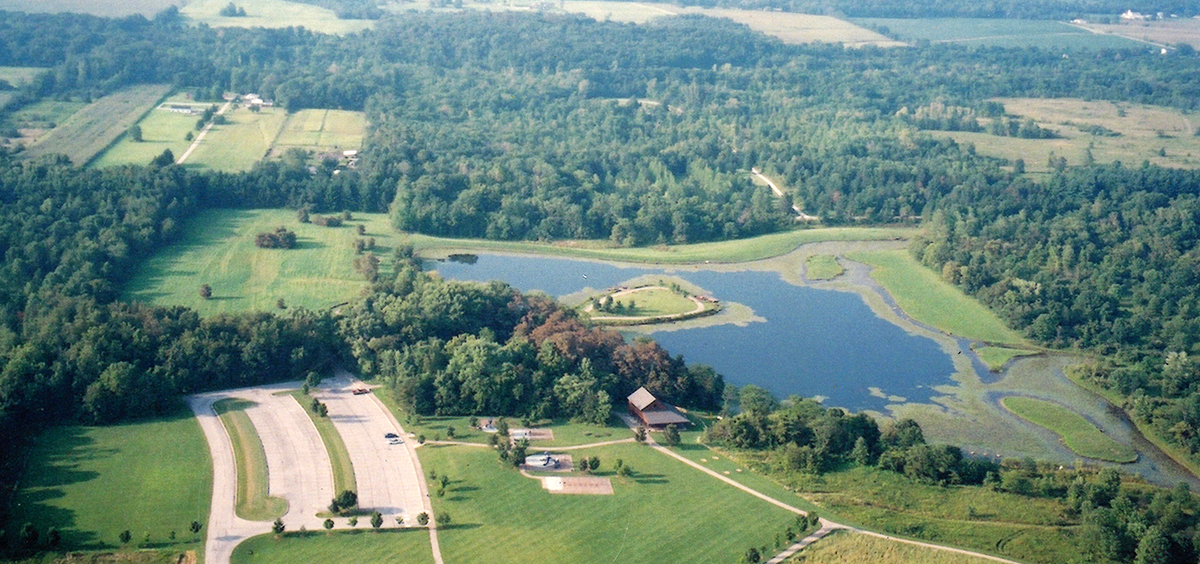
A living historical farm was always the priority, but, at about 150 acres, that would occupy less than 10 percent of the total land area of the park. One idea that never came to fruition envisaged two 18-hole golf courses in the western section of the park. A plan to create a large lake was also on the initial wishlist, but this would not be enacted until 12 years after the park opened. There was a desire for picnic facilities and nature trails, which were ready for the park opening in 1981. This was in the form of a 2.5-mile nature trail and a single picnic area for about 80 people. The trail would later be split and renamed as the 1.5-mile Five-Oaks Trail, and the adjacent 1-mile-loop of the Sugar Maple Trail. In 1993, the 14-acre Buzzard’s Roost Lake was built north of this area, and had its own picnic area and shelter, seating up to 200 people.
A LIVING HISTORICAL FARM
Engineering and architectural studies demonstrated that restoration of three core buildings, the farmhouse, barn, and nearby granary, was a viable prospect. School officials indicated that a living historical farm would be a valuable educational resource for students and that school visits, and visits by other groups, would guarantee large visitor numbers for the farm.
RESTORING THE FARMHOUSE
It was always intended that the farmhouse would be open to visitors, and that parts of it would be used for interpretation, that is, it would be used by staff in such a way as to demonstrate daily life in a farmhouse of the 1880s for visitors to observe and ask questions. The Gothic Revival-style farmhouse was built in 1856 by Isaac Fridley.
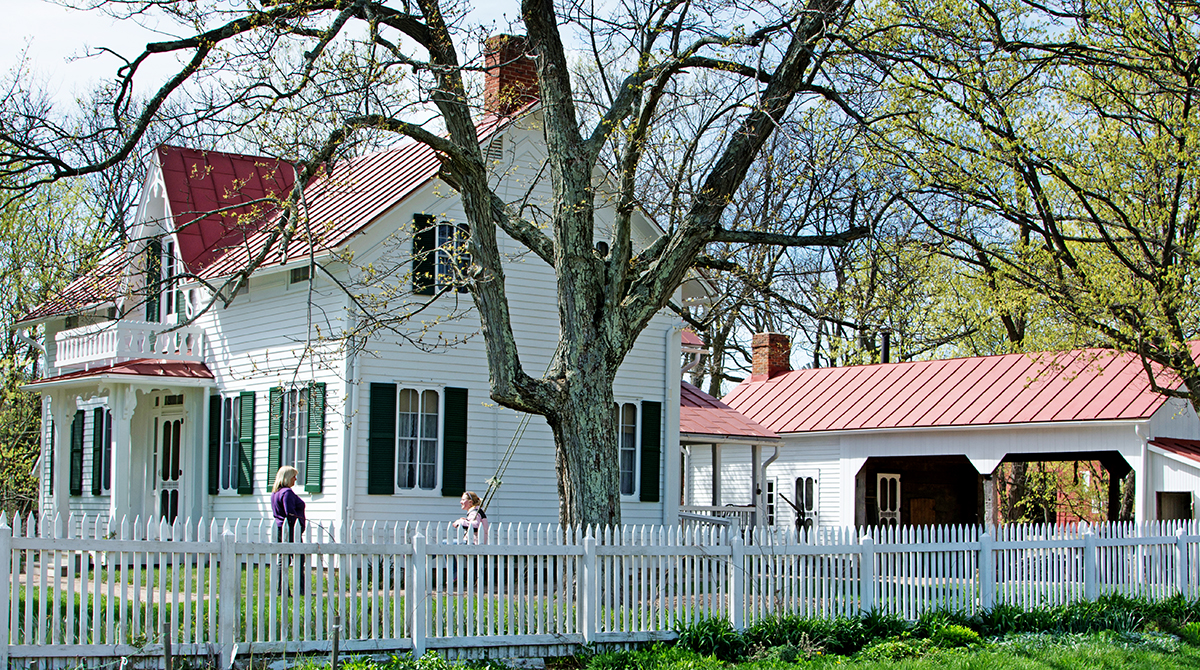
Restoration of the original farmhouse began as early as 1968. The wooden-frame building, made mostly of poplar and walnut, was in generally good condition, but the poplar siding had rotted badly and had to be replaced. As Metro Parks was unable to find poplar siding, redwood siding was used for the replacement, milled to the same size as the original siding. The entire house was repainted, using the original colors of white, with green shutters and a red-painted metal roof. The front porch, with its sloped roof, was structurally unsound and had to be rebuilt from scratch. Decorative woodwork was milled to replicate the look of the original. After the structure was built, and in a delay period before painting would begin, an eastern phoebe built a nest on the trim molding above the portico door. After much debate, it was decided to continue the restoration work, with naturalists opining that the phoebe would likely be able to tolerate the noise and go ahead with family rearing. Which is what happened. Internal restoration work on the farmhouse began later.
THE PARLOR

The best furnished room in a Victorian house was the parlor, but this was often used only for special occasions: weddings, funerals, and for family parties. Parlors were also used by courting couples, to ‘show off’ the family at its best to potential future member of that family. When Metro Parks bought the Fridley house, it was found that the original parlor had been converted into a bathroom and bedroom, with a partition wall. The fireplace had been bricked up and the mantel had been removed. Our research showed that the bricking of the fireplace was done so that the family could heat the room with a parlor stove. Several pieces of the parlor’s original walnut woodwork were missing or in bad condition and had to be replaced, as did some of the oak floorboards. We repapered the parlor walls using a reproduction 19th century wallpaper. To complete the look and feel of the parlor, we brought in various furnishings, including a square grand piano, donated to the farm in 1981. The piano is made of rosewood and was built by the New York Pianoforte Company. In early 2022, we made a major restoration of the piano, bringing it back to its prime. When we removed the keyboard during the renovation, we discovered the piano maker’s name. It is signed John Snyder (from the New York Pianoforte Company) and dated 1868. We also have a second donated musical instrument in the parlor, an Eastlake era pump organ from about the 1870s.
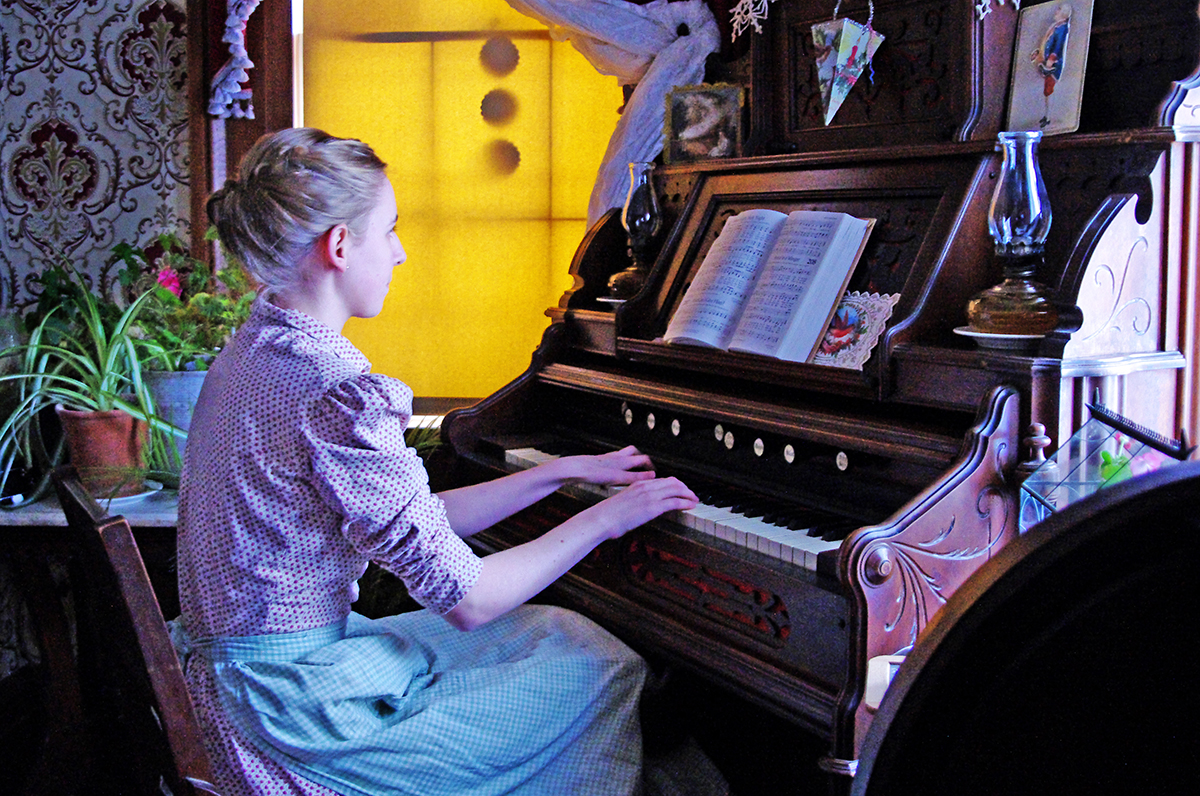
KITCHEN (AND THE SUMMER KITCHEN)
The kitchen was most often the center of activity in an 1880s farmhouse. But when Metro Parks acquired the White farm in 1964, we learned that the location of the kitchen in the 1880s didn’t tie in with its location in 1964. A back porch had been enclosed, and the kitchen moved to that enclosure. Metro Parks decided to restore the 1880s orientation and subsequently built a new external back porch.
The most important piece of equipment in the kitchen is the cookstove. The wood-burning, cast iron cookstove is used on a daily basis to cook dinner for the working staff and volunteers of the Farm. Vegetables are grown on the Farm, and meat is from livestock butchered on the Farm.
Because a cookstove generates so much heat, many farm families in the 1880s would do their cooking in the summer months in a separate building, away from the farmhouse. It was necessary, in order to keep the farmhouse cool during the hot Ohio summers. If a farm family could afford a second cookstove, they would use that for their summer cooking. If not, they would need to disassemble their cookstove, move the parts to the outside building, known as a summer kitchen, and then reassemble it for use there. That’s what we do at Slate Run Living Historical Farm. Twice a year, the cookstove is disassembled and reassembled as it moved back and forth between the farmhouse and the summer kitchen.
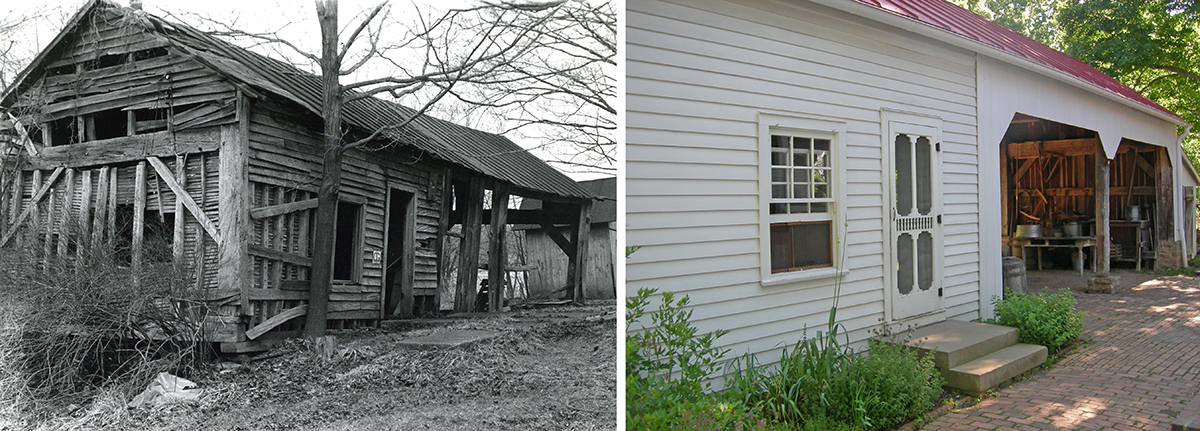
The summer kitchen at Slate Run was dilapidated and on the point of falling down when Metro Parks acquired the property from the White family in 1964. It had a long roof which extended beyond the main structure, to provide a covered open area. There are no records as to when the summer kitchen was built, although historians believe it to have been built around the same time as the farmhouse itself. In 1976, Metro Parks received a grant from the Department of the Interior, so we could rebuild the summer kitchen from scratch. The structure was built based on an old design. Metro Parks uses the summer kitchen year-round, for tasks such as laundry, sausage making, canning, soap making, butchery and cheese making. It is also used for storage.
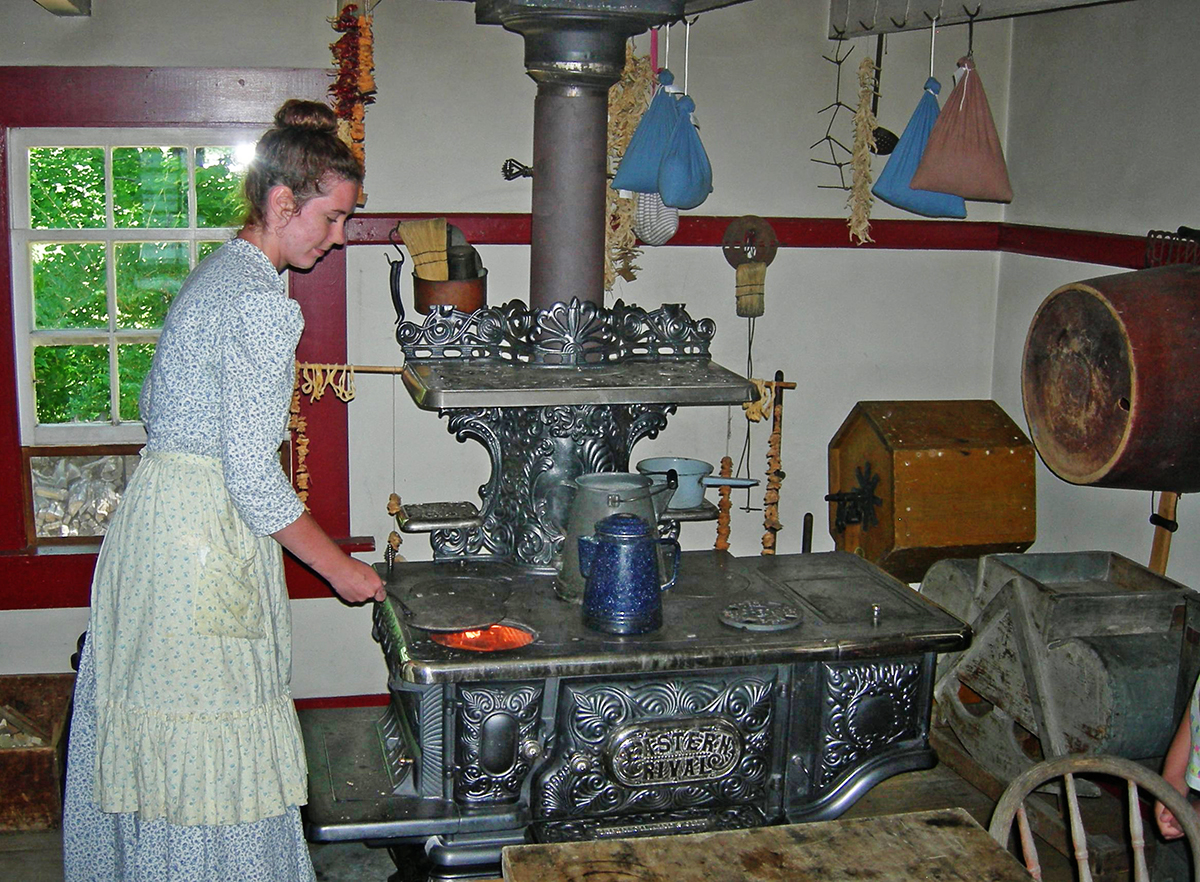
BARN AND GRANARY
Consultations with architectural historians began in 1975 as Metro Parks formulated plans for the restoration of the barn, built by Samuel Oman in 1881. In particular, advice was sought about restoring the cupola on the barn, as the original hexagonal cupola had been destroyed in a storm many years before, and there were no original plans about how the cupola had been constructed and mounted. The barn had been designed originally with a passage for vehicles through the barn on a north-south axis, but over the years, that had been switched to an east-west orientation. Architects and historians agreed that a return to the original orientation would open up the barn to make it look larger, and would allow for a better arrangement of animal stalls.

Our consultations allowed construction plans to be drawn for the build and installation of the cupola. Other aspects of the restoration included the replacement of the barn’s sliding doors at both ends, replacement siding, louvers and animal stalls, repairs to the roof, and the installation of a concealed electrical service. Once all those restorations had been made, the entire exterior of the barn was repainted.
The granary had been moved from its original location. As part of the restoration, we moved it back to its 1880s location, closer to the barn. The granary remodeling included replacement of the roof, siding, doors and grain bins. As with the barn, the exterior was repainted. The granary’s corn cribs hold ears of corn to feed the animals. The slatted sides, used to allow proper ventilation so the corn didn’t go to mold, were fully replaced. The upper floor of the granary is used to store wheat, oats and farm tools.
OTHER BUILDINGS
Other outbuildings and structures were built in the 1880s style, to provide a true restoration of a typical working farm of the 1880s in Pickaway County. These included machine sheds, poultry yards, a hog shed, a root cellar and smokehouse, and an external privy. Most 1880s farmhouses had no internal toilets.
After the buildings were restored, Metro Parks cast a wide net, hoping to garner furnishings and farm equipment from the late 19th century or of the style used in the 1880s. Through a combination of sales and donations of materials, the Farm was made ready to begin functioning as a working farm in 1981, and to demonstrate for modern-day visitors what farm and family life was like before the introduction of electricity or gasoline engines.
In preserving and interpreting the agricultural history of the area, Slate Run Living Historical Farm became a big hit with visitors. For the first 10 years, the Farm charged a small admission fee, but this was dropped after 1990 and all visits and programs were free from then on. Visitors came out in large numbers for public programs designed to demonstrate specific or seasonal aspects of life on a late 19th century farm. Even a casual, day visitor, would get to see farm staff or volunteers, dressed in authentic historical costume, performing daily farm chores. Local schools also took advantage of the new facility for living history classes. Up to 20,000 school children would come out each year for special 2-hour-long guided school tours, led by a Slate Run Farm interpreter, or for self-guided field trips.
FARM PRODUCE
A 5-acre hayfield was established to provide fodder for the farm’s livestock, and four separate 5-acre fields were set aside for cultivation of crops. The separate fields allowed for crop rotation and the good maintenance of soil fertility. All the farm’s crops were 19th-century varieties of corn, wheat, barley, alfalfa and sorghum. Likewise, the farm-grown fruit and vegetables were heirloom varieties of apples and cool weather crops such as peas, onions, kale, lettuce, carrots and beets.
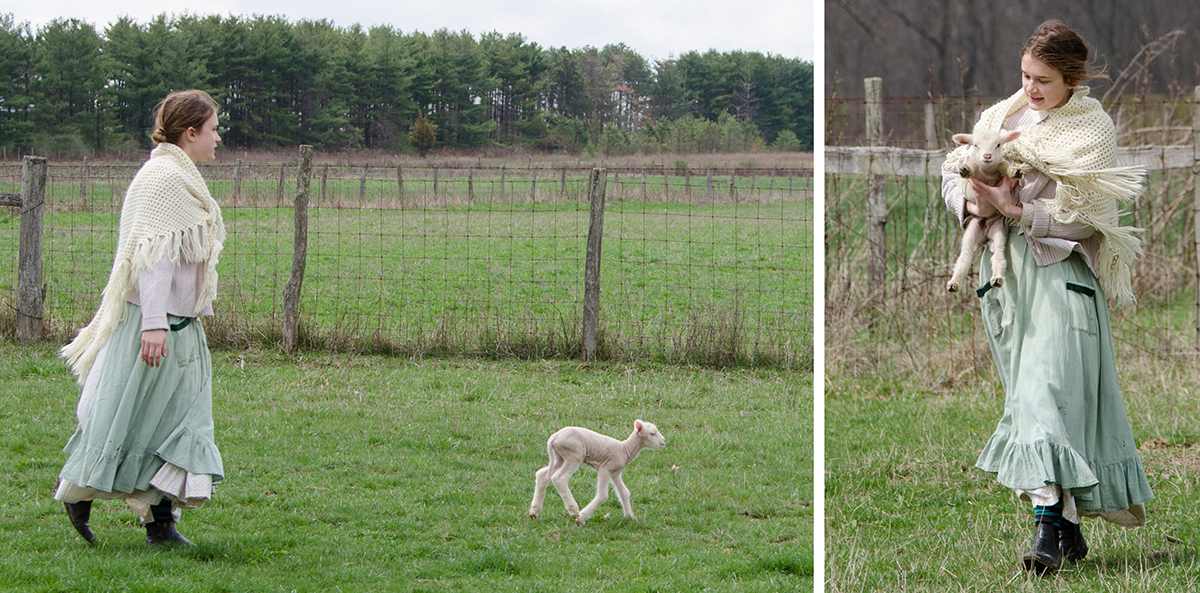
The farm livestock includes buckeye and minorca chickens, merino sheep, short-horned cattle, slate turkeys, Muscovy ducks and Toulouse geese. The livestock are raised for milk products, meat and eggs for the demonstration foodways. Any produce surplus to the needs of the farm workers was sold locally, just as it would have been in the 1880s.

THE WORKING ANIMALS
Unlike the livestock, the farm’s workhorses have names and are regarded with respect and affection as partners in the work of the farm. From the outset of the farm’s operation in 1981, the farm has used Percheron horses. The breed originated in an area of France called Le Perche, southwest of Normandy. These noble and powerful animals were first imported into America in 1839. Within 40 years, they had become America’s favorite work horse.
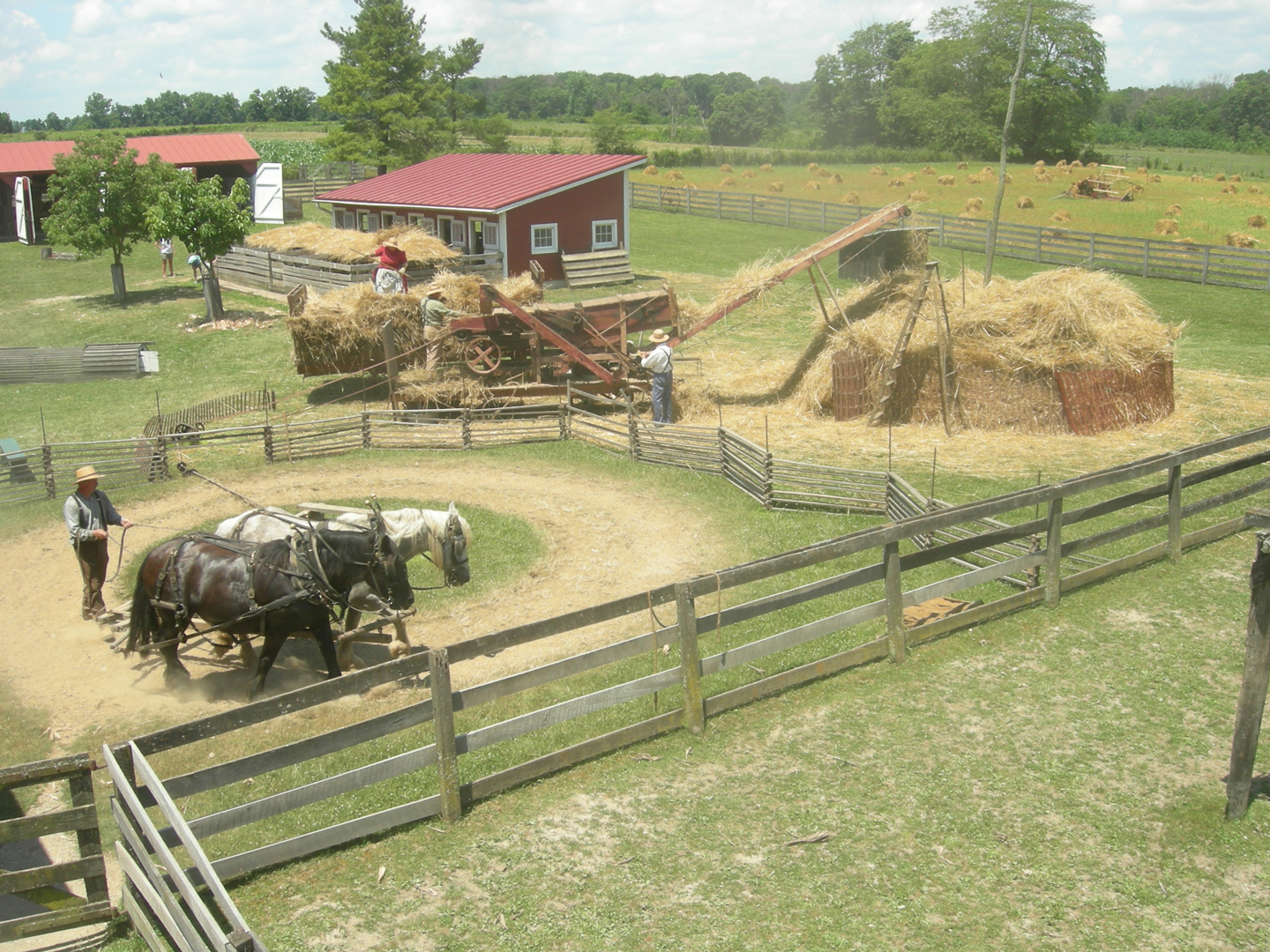
There are usually four Percheron horses on “staff” at one time. They are the “power” behind all the mechanized work on the farm. Weighing up to 1800 pounds, the Percherons often work in pairs. They are harnessed and hitched to mechanical equipment, such as a manure spreader, various plows, harrows and cultivators. Perhaps the hardest working days, for the Percheron horses, are the wheat threshing days in July. Threshing separates the grain from the wheat stalks and seed covering and is the final stage of the wheat harvest. The horses, again working in pairs, walk in a circle around a series of gears, called a horsepower, which transmits power via a tumble rod and belt to the threshing machine.
Present day farmer at Slate Run, Dave Trotter, fondly recalls working with two horses in particular, Kate and Maude. They were his partners for more than 20 years, until they retired and were adopted by Friends for Life Animal Rescue. In their early days of working together, Dave says Kate (a black horse) and Maude (a white horse) taught him a valuable lesson, that horses “don’t have brakes!” When he was riding the cultivator, hitched to Kate and Maude, they suddenly stepped backwards instead of forwards, and as the cultivator’s pointed diggers were in the ground, the combined momentum of 3,600 pounds bent the front of the cultivator into a ‘V’. That was, as Dave describes it, the only “bone-headed move” that he and the horses made in over 20 years of their partnership. On that occasion, he had to unhitch the horses from the cultivator so that it could be retrieved and repaired.
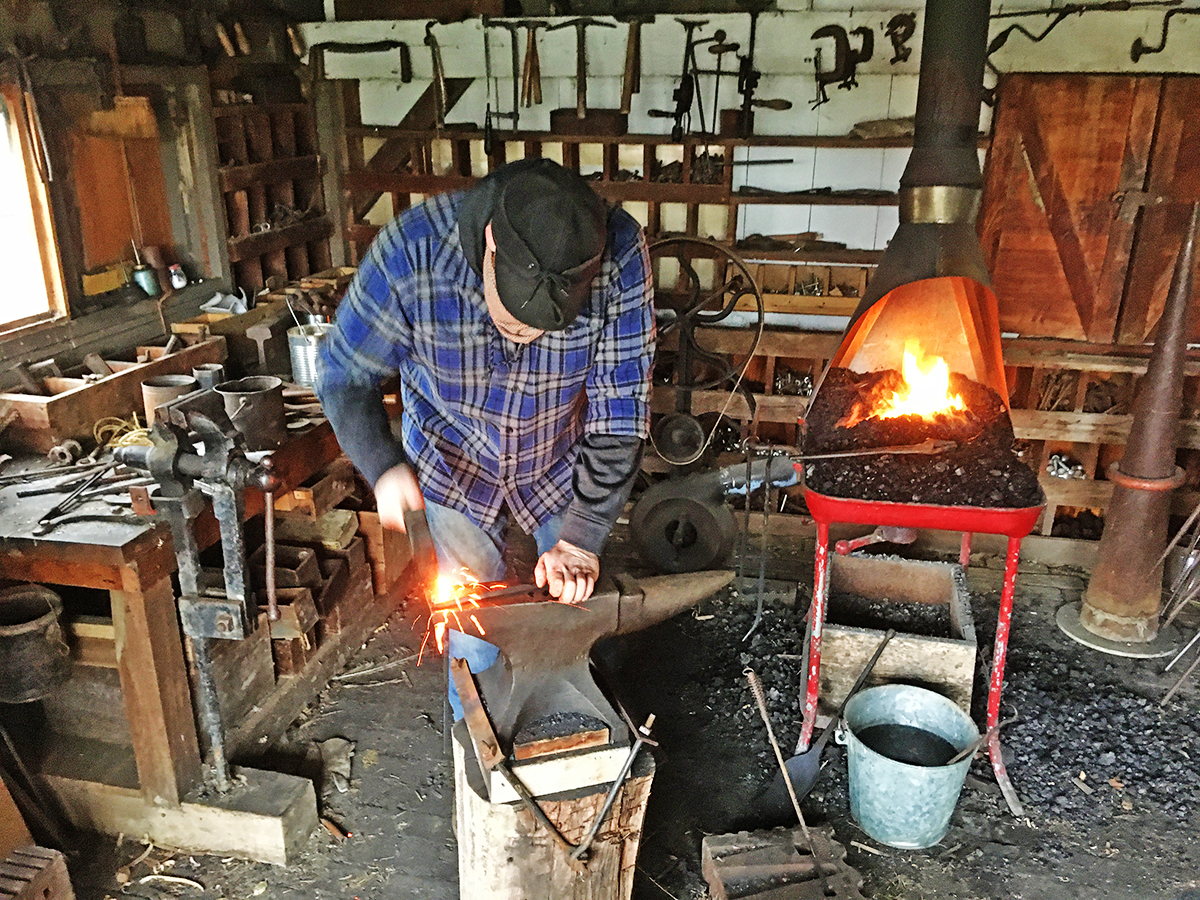
Repairs to the mechanized equipment are made by farm staff themselves, using the Farm’s blacksmithing forge or woodworking shop. If equipment needs to be replaced, or parts cannot be repaired, the Farm often finds replacements at Amish area auctions or junk yards.
A NEW LAKE AND PICNIC AREA
As part of the planned expansion of facilities at Slate Run, Metro Parks had a 14-acre lake built in 1993, with a boardwalk, two fishing docks and a spotting scope, so that visitors could get close-up views of wildlife using the lake. A large shelter was built nearby, seating up to 200 people, and the combined Buzzard’s Roost Lake and Buzzard’s Roost Picnic Area was born. The park’s original picnic area was then granted a name, the Shady Grove Picnic Area. Buzzard’s Roost Lake was stocked with blue gill and large-mouthed bass for fishing.
In 2006, the first signs were noted of increasing aquatic vegetation at the lake, which became more pronounced over the succeeding years. In early 2014, a report identified factors behind this increasing problem. Excessive sedimentation from the original construction, and the effects of an overly-large geese population (the geese were attracted because the lake’s water fountain kept the lake open and free of ice during some of the harsher winters of the mid- and late-1990s) and their droppings, contributed to
a build up of nutrients on which the aquatic weeds thrived. To combat the issue, Metro Parks developed and contracted a renovation project in 2015. The work was fully successful in improving the water quality and restoring the original depths of the lake.
A COVERED BRIDGE
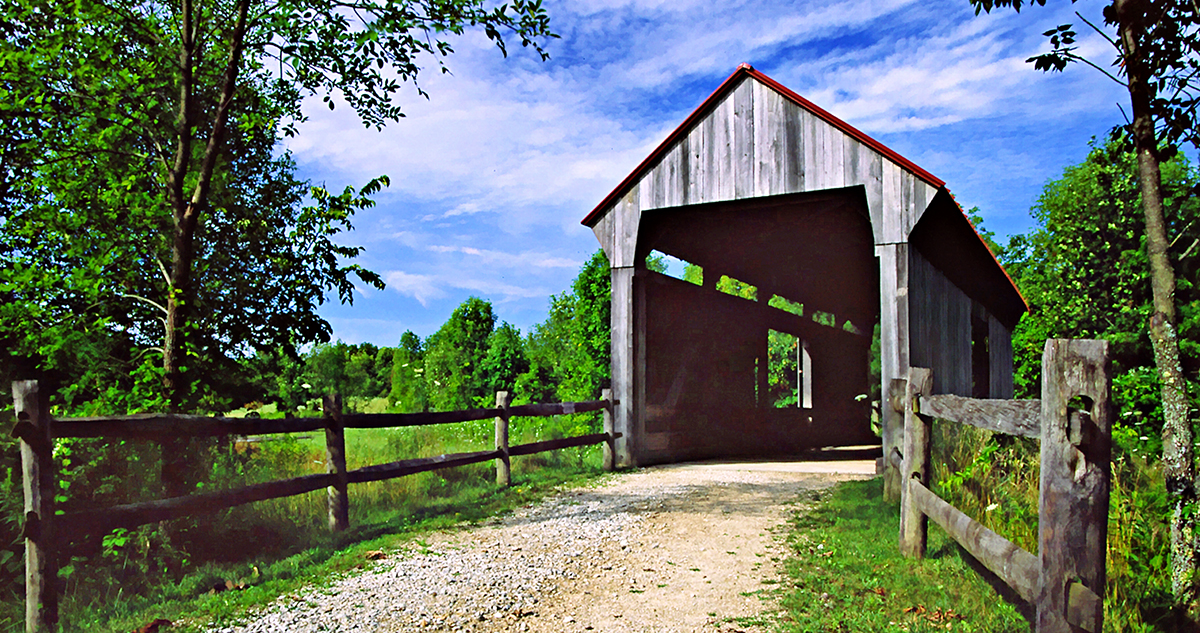
Slate Run is the only Metro Park with a covered bridge. The Blackburn Bridge was built in 1895 and originally spanned Brannon’s Fork in Muskingum County. To preserve the bridge, which would otherwise have been demolished because of plans to begin strip-mining in the immediate area, Arthur Wesner purchased the bridge in 1967. He dismantled and then reassembled the bridge on his own land along Big Run Creek. In 1998, he donated the bridge to Metro Parks. The Metro Parks Roving Crew restored the 53-foot-long bridge and located it on a new trail at Slate Run, appropriately called the Covered Bridge Trail, just south of Buzzard’s Roost Lake.
HORSES FOR COURSES
Long before the park opened, four alternative schematic plans all mentioned a desire to incorporate facilities for horse riders at the future Slate Run Metro Park. It took a long time to come to fruition, but finally, in September 1999, the 2.5-mile Sassafras Trail was opened, for horse riding only. The bridle trail has its own entrance on Duvall Road and features a trail head with parking space for up to five horse trailers. The trail is a favorite of the Ohio Horseman’s Council. It passes through forests and open meadows and crosses a shallow creek.
THE SLATE RUN WETLANDS
Metro Parks’ first major wetland restoration project took place at Slate Run Metro Park. In late 1997 the Ohio Wetlands Foundation (OWF) contacted Metro Parks and expressed interest in identifying potential wetland restoration sites in the park district. As part of the EPA’s Clean Water Act, property developers were under a legal requirement to replace, or mitigate, wetlands that were lost because of land development. So called wetland mitigation banks were identified, these being areas where restored wetlands might be created as part of the legal process. OWF worked with conservation agencies and with the US Army Corps of Engineers to evaluate potential sites for these ‘mitigated’ or replacement wetlands.
After a prolonged period of land evaluation and engineering surveys, Metro Parks agreed to participate in the construction and restoration of a 156-acre wetland at Slate Run. Located in the western sector of the park, initial park development plans had envisaged a potential golf course here, but that hadn’t proven feasible. The engineering surveys demonstrated that the area had been a wetland prior to European settlement of the area, most likely being a sedge meadow type wetland, with additional shallow water areas. OWF provided funding for all the engineering, administrative, construction and vegetation costs of the wetland development. Construction work began in April 1999. As part of the construction process, more than 100,000 cubic yards of dirt were moved to create berms, or artificial embankments for the wetland cells. Depressions of different depths were created, for different types of wetland cells, and dikes were built up to form the grounding for future trails. In order to alleviate erosion and to provide habitat for wildlife, wildflower and grass seeds were sown to cover the areas between the ponds and the future trails.
As part of the restoration plans, numerous different style of wetland habitats were conceived, such as shallow water mixed emergent marshes, mud flats, sedge meadows, wet prairies, shrubby wetland areas, and some pools of deep, permanent water.
Work continued for several years to develop public access to the wetlands. A 1.5-mile trail, the Kokomo Wetland Trail, passes through the wetlands and includes three observation decks, one of which hosts a 50x spotting scope to allow great close-up views of wildlife, plus 600 feet of boardwalk that intersects one of the wetland cells. Another trail was built to connect the wetlands with the rest of the park. The 1.5-mile Bobolink Grassland Trail passes through a 135-acre grassland bird management area and connects with the Sugar Maple Trail. Now there are more than 7 miles of hiking trails at the park, plus the 2.5-mile bridle trail for horse riding only, and the 2-mile Camp Starview Trail in the reservable day camp area.
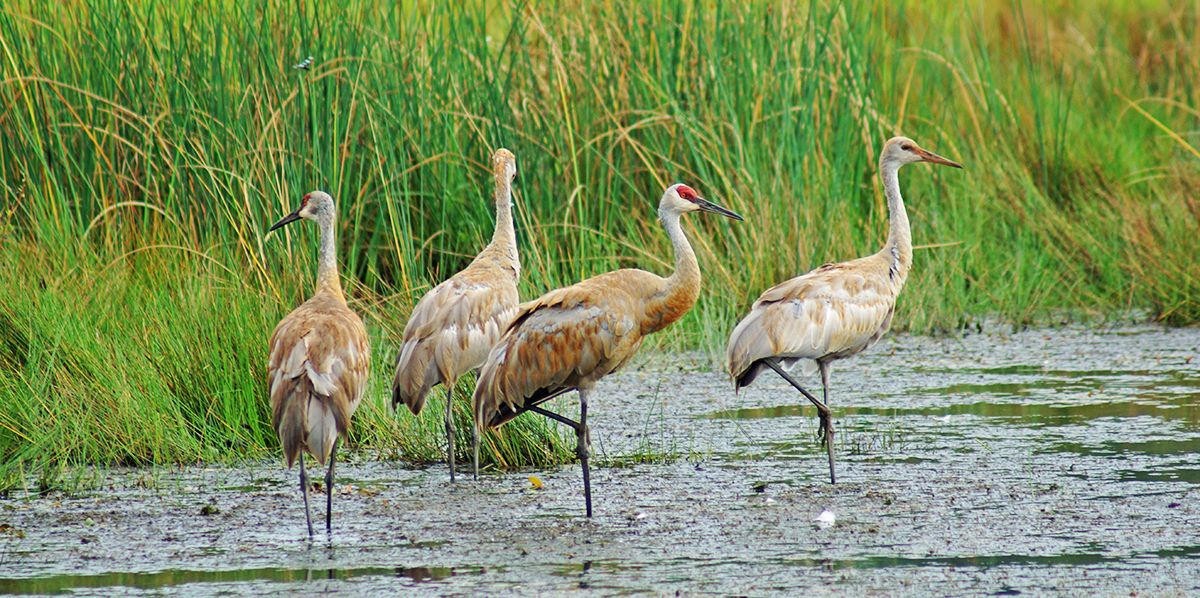
The Slate Run Wetlands have become a great resource for birds, and for birders. In the first decade, more than 125 avian species were recorded at the site, many of them never seen at the park before. The wetlands were used as nesting sites by such species as least bitterns, blue-winged teal, and most excitingly of all, sandhill cranes. This was the first record of sandhill cranes nesting in central Ohio in more than 100 years. These large, heavy, yet elegant birds have a distinctive look, with plumage of various shades of gray and brown, black legs, and a very distinctive red crown, on top of the head. The sandhill cranes at Slate Run have raised colts each year since they were first identified as nesting there in the late 2000s.
The Wetlands also became very popular as an educational site for school classes, and naturalist-led tours have brought tens of thousands of school children to the site over the years. The tours demonstrate not just the natural beauty of the wetlands, but also highlight the importance of wetlands in flood control and water purification, as they absorb and remove sediments and pollutants from stormwater runoff.
SLATE RUN TODAY
The Slate Run Living Historical Farm continues to be a premier attraction. More than half of Slate Run’s 1,705 acres are forested, and the park features a contiguous and maturing 350-acre woodland, forming one of Pickaway County’s largest single forested areas. It is dissected be Slate Run Creek and its many tributaries, and is dominated by mature oaks, beech and hickory trees. Pawpaws, redbud, dogwoods and Ohio buckeyes are prominent beneath the forest canopy.
The 135-acre grasslands are a great place to see grassland birds such as bobolinks, eastern meadowlarks and several species of sparrows, including Henslow’s, savannah and grasshopper sparrows. The Wetlands continue to thrive and have developed into one of the premier butterfly and birding sites in Central Ohio. Slate Run was the first park at which we started a bobwhite quail reintroduction program. It started in 2012, in the grasslands east of the wetlands. This continuing reintroduction program is proving successful and quail are now breeding and populating the grasslands, wetlands, and other areas of the park.
The park created a 7-acre natural play area on a wooded hillside bordered by a creek, which allows kids and adults to connect with nature and discover the fun and adventure of outdoor play. Last year, Slate Run hosted its annual Fall Fest, which was first organized in 1998 and features hay rides through the park, a corn maze, a giant leaf pile, free pumpkins from the pumpkin patch, and plenty of family games and entertainment. A nearby area is full of sugar maples, providing stunning fall color. It is also used as the park’s Sugarbush, to tap for maple sap in February. The sap is later boiled down at the Living Historical Farm, and made into maple syrup and candies.

How do you sign up to visit Slate Run? I would love to come in the Spring or Summer?
Kathleen, There is no necessity to sign up to visit Slate Run Metro Park or the Slate Run Living Historical Farm. In spring and summer, as well as a casual visit, there are numerous public programs held at the Farm. The park is open every day. Slate Run Living Historical Farm is open April 1-September 30: Tuesday, Wednesday, Thursday and Sunday, 9am to 6pm and Friday and Saturday, 9am to 7pm, AND October 1-March 31: Tuesday, Wednesday, Thursday and Sunday, 9am to 5pm, and Friday and Saturday, 9am to sunset. Please note: From January to March, the Farm grounds and barn are open, but some buildings are closed and activities reduced due to the winter season. All programs and activities resume in April.
Our famy only lived in Worthington a short time but Slate Run Farm is a favorite memory of our time in Ohio. our children the 9 and 2 loved it
. Your Halloween event was fun. We are there around 1986 1987. Thank you
Slate Run is such a wonderful resource, especially those of us living close by. I have watched it grow since opening, and now it’s one of my primary photography areas. It is also where I captured my first Sandhill Crane pictures in 2021. Having Slate Run close by helped me endure the isolation of Covid by providing a place for activities and fresh air.
We are fortunate to be blessed to have so many metroparks in close proximity to Groveport!
Virginia,
Such an informative article with many intriguing anecdotes to pique interest in this, one of many, Metroparks!
Thank you, Joyce.
As a Girl Scout Leader in Reynoldsburg in the mid-late 70’s I was fortunate enough to camp at Slate Run during our annual GS CAMPOREE. this was before many of the wonderful additions were made. For a city girl it was quite an experience. What a wonderful addition to the Metro Park System. Keep preserving and growing!